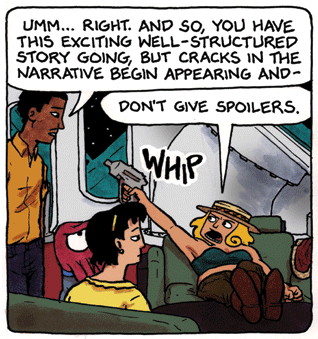Saturday I went up to the Alternative Press Expo in San Francisco for a few hours. I had fun there last year, and was looking forward to picking up some new stuff.
The con was largely the same this year as last, although it seemed like there were slightly fewer exhibitors (the central space around the stairs was empty). It also seemed that the exhibitors had been arranged differently than last year, with exhibitors selling books on one side of the long hall, and exhibitors mainly selling artwork and crafts on the other side. But that might have been been a coincidence.
I was disappointed that neither Spike of Templar, AZ nor Dylan Meconis of Family Man were there, as I’d regretted not buying their collections last year, and I haven’t been very successful at catching up on their webcomics since then, so I figured reading them in print would make it easier to catch up. (More on this later.) Guess I’ll have to pick them up through their stores.
However, I did have a great time chatting with Christopher Baldwin of the humorous space opera adventure strip Spacetrawler. Apparently he’s been doing webcomics since 1996 (!). I picked up the first collection of the strip (which looks like a really nice color package!), and also the first volume of his earlier strip, Little Dee. I asked if he read the webcomic Drive, which is the only other humorous space opera webcomic I can think of, which he does.
We also talked about getting into webcomics, and how a comic with a substantial history can be hard to get into because it takes a while to catch up. He said he’s been reading Questionable Content, but is only 300 strips in, which means he has over 1700 strips to go! Funny how this was never a concern for newspaper strips, but on the web, where the whole archive can be made available, one almost feels an obligation to read the older stuff. Well, I do, anyway. And for strips with an ongoing storyline, like Spacetrawler or other dramatic strips, it’s almost necessary.
He did some sketches for me, and I asked if he uses a Rapidograph pen to draw the strip, since he used it to ink one of the sketches. This led to a discussion of art tools, which I found interesting despite my own long-atrophied art skills, and given the development of computerized drawing tools. It was kind of heartening to learn that he gains some satisfaction from doing the art on a physical medium.
Anyway, it was a lot of fun chatting with him. It sounds like he’s been making the convention rounds this year, so if you see him at a con, check out his work.
I also visited Travis Hanson, whose strip The Bean I discovered at least year’s APE. He’s currently transitioning the strip over from a stapled pamphlet format (i.e., like other comic books) to (I think) a paperback format, so he didn’t have the 8th issue of The Bean available. However, I did pick up a copy of his recent print The Kiss, which we’ll frame and put up in our bedroom with the other two framed prints of his art we own.
And then I picked up the first volume of Carpe Chaos, another science fiction webcomic, although a more serious one than Spacetrawler. I’d come across it before but haven’t caught up on it (there’s that phrase again). It’s slightly more intimidating than other webcomics because it’s a series of short stories, apparently published simultaneously, and taking place at different times, so you can’t just follow the story linearly through the RSS feed. But I enjoyed the volume I bought and I’ll give it a try.
I sampled several other books while walking around, but didn’t come across any others I wanted to buy. Perhaps my standards are high: I prefer fairly polished artwork, so (for example) I’ve never been able to get into Kate Beaton‘s strip. I also much prefer color strips; if you’re doing a black-and-white strip, I almost want the art to be of higher quality than a color strip. (Some artists prefer black and white art, especially for line art, but I’ve always been the opposite.)
I also ran into a former cow-orker of mine and we chatted for about 20 minutes. Nice to catch up. He lives up there, so we don’t see each other much now that he’s left the company.
A good trip, all-in-all. I spent about 4 hours wandering the floor, taking CalTrain to and from the show. I’ll probably go back again next year.






